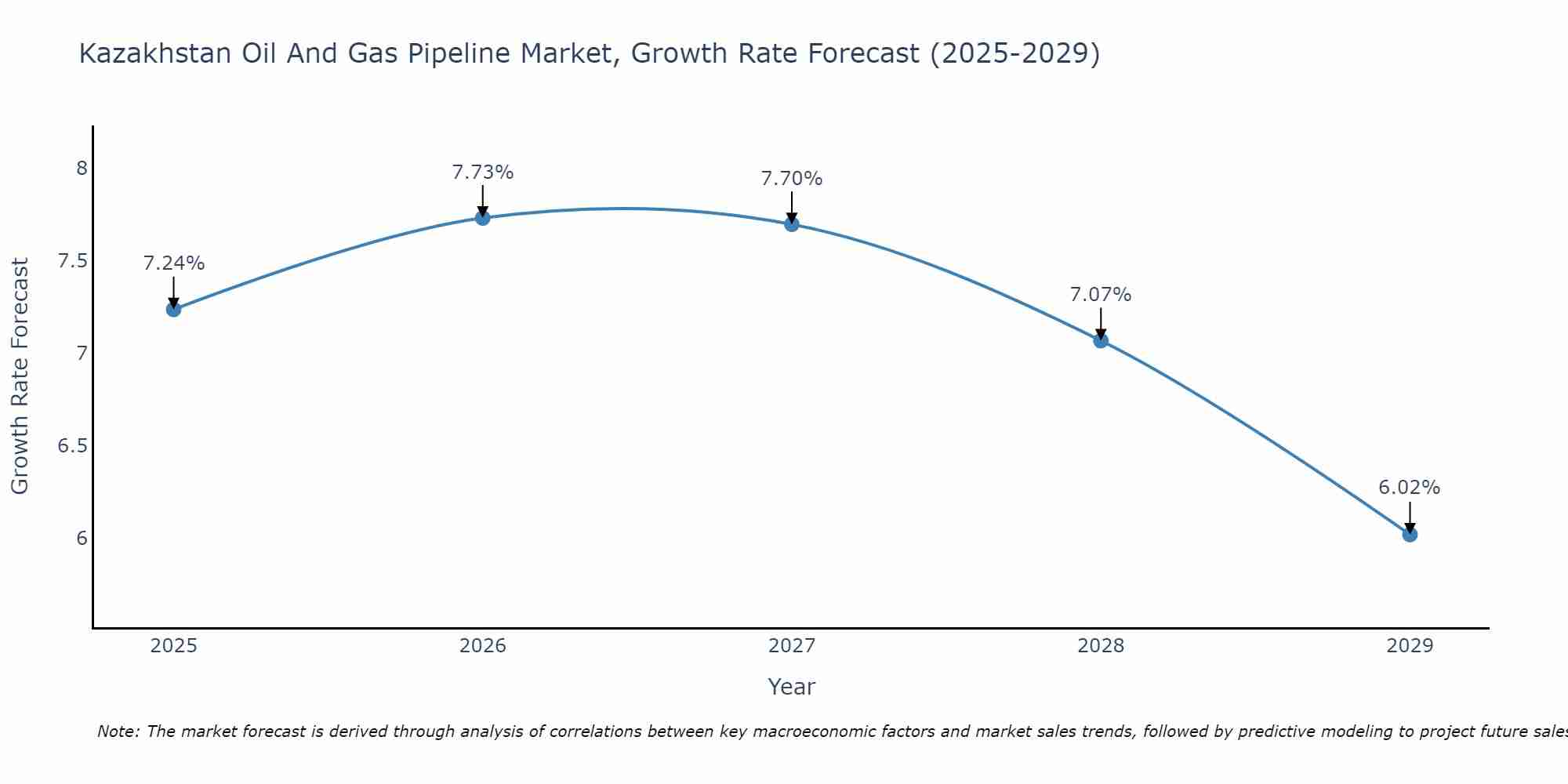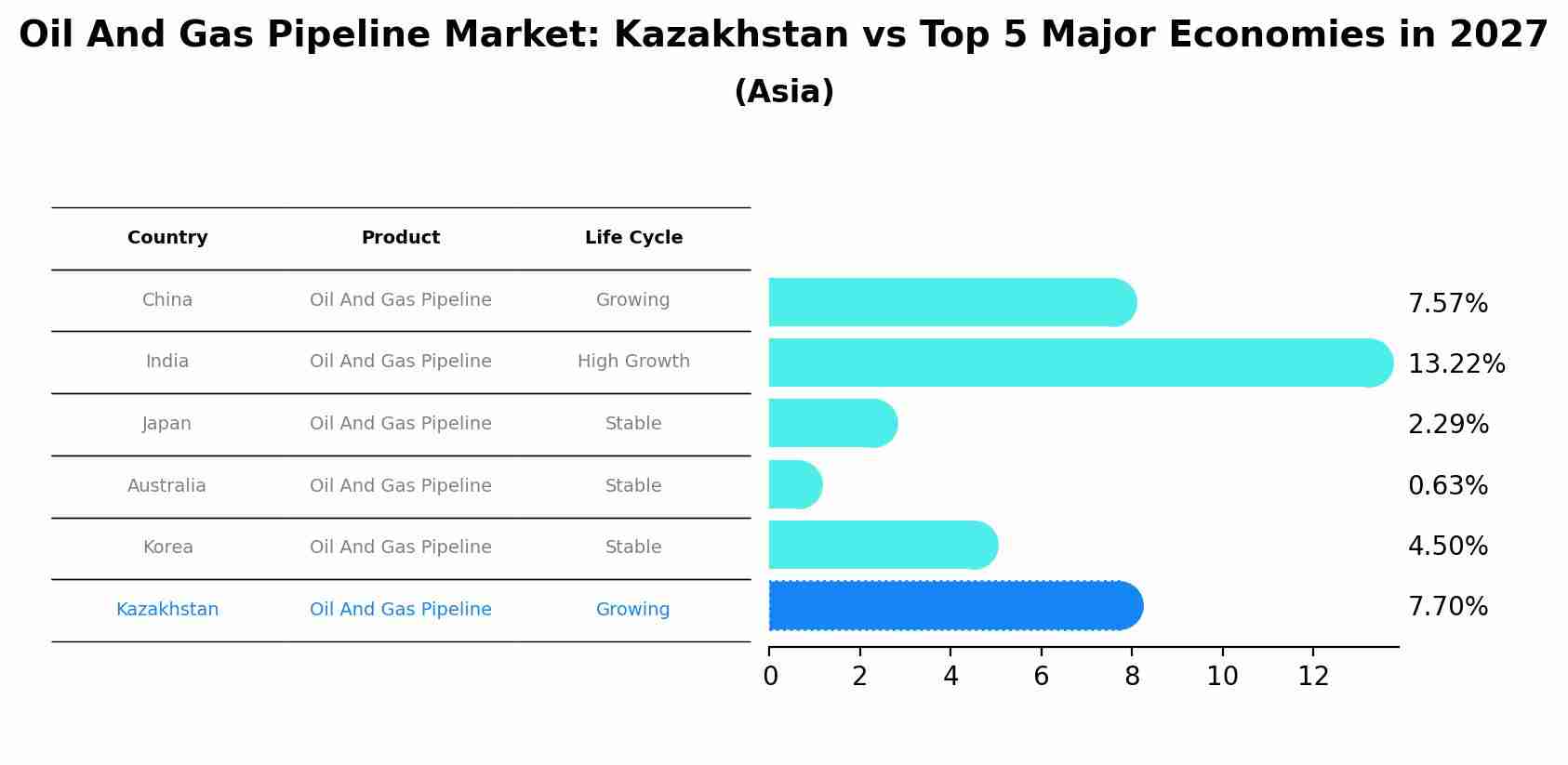Kazakhstan Oil And Gas Pipeline Market Outlook | Growth, Industry, Value, Analysis, Share, Trends, Revenue, Companies, COVID-19 IMPACT, Forecast & Size
| Product Code: ETC377338 | Publication Date: Aug 2022 | Updated Date: Jul 2025 | Product Type: Market Research Report | |
| Publisher: 6Wresearch | Author: Ravi Bhandari | No. of Pages: 75 | No. of Figures: 35 | No. of Tables: 20 |
Kazakhstan Oil And Gas Pipeline Market Size Growth Rate
The Kazakhstan Oil And Gas Pipeline Market is projected to witness mixed growth rate patterns during 2025 to 2029. Growth accelerates to 7.73% in 2026, following an initial rate of 7.24%, before easing to 6.02% at the end of the period.

Oil And Gas Pipeline Market: Kazakhstan vs Top 5 Major Economies in 2027 (Asia)
Kazakhstan's Oil And Gas Pipeline market is anticipated to experience a growing growth rate of 7.70% by 2027, reflecting trends observed in the largest economy China, followed by India, Japan, Australia and South Korea.

Kazakhstan Oil And Gas Pipeline Market Synopsis
The Kazakhstan Oil and Gas Pipeline Market is a crucial sector within the country`s energy industry, given its abundant oil and gas reserves. The market is characterized by a network of pipelines that transport oil and gas from production fields to refineries and export terminals. Key players in the market include major oil and gas companies such as KazMunayGas and Tengizchevroil. The infrastructure in Kazakhstan includes both domestic pipelines for supplying energy to local markets and export pipelines that connect the country to international markets, particularly in Europe and Asia. The market is influenced by factors such as government regulations, geopolitical dynamics, and global oil prices. As Kazakhstan continues to develop its energy sector, investments in pipeline infrastructure are expected to play a significant role in ensuring efficient transportation of oil and gas resources.
Kazakhstan Oil And Gas Pipeline Market Trends
The Kazakhstan Oil and Gas Pipeline Market is experiencing several key trends. One significant trend is the expansion of pipeline infrastructure to facilitate the transportation of oil and gas from production sites to export terminals, driven by increasing production volumes. Another trend is the adoption of advanced technologies such as smart pipeline monitoring systems to enhance operational efficiency and ensure regulatory compliance. Additionally, there is a growing focus on implementing environmentally sustainable practices in pipeline operations, including the use of eco-friendly materials and reducing carbon emissions. The market is also witnessing partnerships and collaborations between domestic and international companies to leverage expertise and resources for pipeline development projects. Overall, these trends reflect the industry`s efforts to modernize infrastructure, improve efficiency, and meet sustainability goals in the Kazakhstan Oil and Gas Pipeline Market.
Kazakhstan Oil And Gas Pipeline Market Challenges
In the Kazakhstan Oil and Gas Pipeline Market, some of the key challenges include regulatory uncertainties, geopolitical risks, and fluctuating oil prices. Regulatory uncertainties can create obstacles for project development and investment decisions due to inconsistent policies and regulations. Geopolitical risks, such as tensions with neighboring countries or changes in government priorities, can impact the stability of pipeline projects and operations. Additionally, the volatility of oil prices can affect the profitability and feasibility of pipeline projects, leading to delays or cancellations. These challenges highlight the need for careful risk assessment, strategic planning, and collaboration with stakeholders to navigate the complexities of the Kazakhstan Oil and Gas Pipeline Market.
Kazakhstan Oil And Gas Pipeline Market Investment Opportunities
Investment opportunities in the Kazakhstan Oil and Gas Pipeline Market include participating in the development and expansion of the country`s pipeline infrastructure to support the growing energy sector. This can involve investing in the construction of new pipelines, upgrading existing infrastructure, and implementing advanced technology for pipeline monitoring and optimization. Additionally, there are opportunities for investment in pipeline maintenance and repair services, as well as in the transportation and distribution of oil and gas products within Kazakhstan and to international markets. With Kazakhstan being a key player in the Central Asian energy sector, investing in its oil and gas pipeline market presents potential for long-term growth and returns for investors willing to capitalize on the country`s strategic position and energy resources.
Jordan Agar Market Government Policies
Government policies related to the Kazakhstan Oil and Gas Pipeline Market include the Law on Subsoil and Subsoil Use, which regulates the exploration, production, and transportation of oil and gas resources, as well as the Law on Natural Monopolies, which governs the activities of companies operating in the pipeline sector. The government has also implemented measures to attract foreign investment in the energy sector through various incentives and tax breaks. Additionally, Kazakhstan is a member of the Eurasian Economic Union, which aims to facilitate trade and economic cooperation among member states, potentially impacting pipeline infrastructure and regulations in the region. Overall, the government`s policies are focused on promoting investment, ensuring efficient transportation of oil and gas resources, and complying with international standards and agreements.
Kazakhstan Oil And Gas Pipeline Market Future Outlook
The future outlook for the Kazakhstan Oil and Gas Pipeline Market appears positive, driven by the country`s strategic location as a key transit route for energy resources from Central Asia to global markets. Investments in infrastructure development, including the construction of new pipelines and expansion of existing networks, are expected to support the market growth. The government`s focus on promoting energy exports and attracting foreign investment in the sector further contributes to the optimistic outlook. However, challenges such as geopolitical risks, fluctuating global oil prices, and environmental concerns may impact the market in the long term. Overall, the Kazakhstan Oil and Gas Pipeline Market is poised for expansion, supported by ongoing investments and favorable government policies.
Key Highlights of the Report:
- Kazakhstan Oil And Gas Pipeline Market Outlook
- Market Size of Kazakhstan Oil And Gas Pipeline Market, 2021
- Forecast of Kazakhstan Oil And Gas Pipeline Market, 2031
- Historical Data and Forecast of Kazakhstan Oil And Gas Pipeline Revenues & Volume for the Period 2018 - 2031
- Kazakhstan Oil And Gas Pipeline Market Trend Evolution
- Kazakhstan Oil And Gas Pipeline Market Drivers and Challenges
- Kazakhstan Oil And Gas Pipeline Price Trends
- Kazakhstan Oil And Gas Pipeline Porter's Five Forces
- Kazakhstan Oil And Gas Pipeline Industry Life Cycle
- Historical Data and Forecast of Kazakhstan Oil And Gas Pipeline Market Revenues & Volume By Location of Deployment for the Period 2018 - 2031
- Historical Data and Forecast of Kazakhstan Oil And Gas Pipeline Market Revenues & Volume By Onshore for the Period 2018 - 2031
- Historical Data and Forecast of Kazakhstan Oil And Gas Pipeline Market Revenues & Volume By Offshore for the Period 2018 - 2031
- Historical Data and Forecast of Kazakhstan Oil And Gas Pipeline Market Revenues & Volume By Type for the Period 2018 - 2031
- Historical Data and Forecast of Kazakhstan Oil And Gas Pipeline Market Revenues & Volume By Crude Oil Pipeline for the Period 2018 - 2031
- Historical Data and Forecast of Kazakhstan Oil And Gas Pipeline Market Revenues & Volume By Gas Pipeline for the Period 2018 - 2031
- Kazakhstan Oil And Gas Pipeline Import Export Trade Statistics
- Market Opportunity Assessment By Location of Deployment
- Market Opportunity Assessment By Type
- Kazakhstan Oil And Gas Pipeline Top Companies Market Share
- Kazakhstan Oil And Gas Pipeline Competitive Benchmarking By Technical and Operational Parameters
- Kazakhstan Oil And Gas Pipeline Company Profiles
- Kazakhstan Oil And Gas Pipeline Key Strategic Recommendations
Frequently Asked Questions About the Market Study (FAQs):
- Single User License$ 1,995
- Department License$ 2,400
- Site License$ 3,120
- Global License$ 3,795
Search
Related Reports
- ASEAN Bearings Market (2025-2031) | Strategy, Consumer Insights, Analysis, Investment Trends, Opportunities, Growth, Size, Share, Industry, Revenue, Segments, Value, Segmentation, Supply, Forecast, Restraints, Outlook, Competition, Drivers, Trends, Demand, Pricing Analysis, Competitive, Strategic Insights, Companies, Challenges
- Europe Flooring Market (2025-2031) | Outlook, Share, Industry, Trends, Forecast, Companies, Revenue, Size, Analysis, Growth & Value
- Saudi Arabia Manlift Market (2025-2031) | Outlook, Size, Growth, Trends, Companies, Industry, Revenue, Value, Share, Forecast & Analysis
- Uganda Excavator, Crane, and Wheel Loaders Market (2025-2031) | Strategy, Consumer Insights, Analysis, Investment Trends, Opportunities, Growth, Size, Share, Industry, Revenue, Segments, Value, Segmentation, Supply, Forecast, Restraints, Outlook, Competition, Drivers, Trends, Demand, Pricing Analysis, Competitive, Strategic Insights, Companies, Challenges
- Rwanda Excavator, Crane, and Wheel Loaders Market (2025-2031) | Strategy, Consumer Insights, Analysis, Investment Trends, Opportunities, Growth, Size, Share, Industry, Revenue, Segments, Value, Segmentation, Supply, Forecast, Restraints, Outlook, Competition, Drivers, Trends, Demand, Pricing Analysis, Competitive, Strategic Insights, Companies, Challenges
- Kenya Excavator, Crane, and Wheel Loaders Market (2025-2031) | Strategy, Consumer Insights, Analysis, Investment Trends, Opportunities, Growth, Size, Share, Industry, Revenue, Segments, Value, Segmentation, Supply, Forecast, Restraints, Outlook, Competition, Drivers, Trends, Demand, Pricing Analysis, Competitive, Strategic Insights, Companies, Challenges
- Angola Excavator, Crane, and Wheel Loaders Market (2025-2031) | Strategy, Consumer Insights, Analysis, Investment Trends, Opportunities, Growth, Size, Share, Industry, Revenue, Segments, Value, Segmentation, Supply, Forecast, Restraints, Outlook, Competition, Drivers, Trends, Demand, Pricing Analysis, Competitive, Strategic Insights, Companies, Challenges
- Israel Intelligent Transport System Market (2025-2031) | Strategy, Consumer Insights, Analysis, Investment Trends, Opportunities, Growth, Size, Share, Industry, Revenue, Segments, Value, Segmentation, Supply, Forecast, Restraints, Outlook, Competition, Drivers, Trends, Demand, Pricing Analysis, Competitive, Strategic Insights, Companies, Challenges
- Uganda Precast and Aggregate Market (2025-2031) | Strategy, Consumer Insights, Analysis, Investment Trends, Opportunities, Growth, Size, Share, Industry, Revenue, Segments, Value, Segmentation, Supply, Forecast, Restraints, Outlook, Competition, Drivers, Trends, Demand, Pricing Analysis, Competitive, Strategic Insights, Companies, Challenges
- Australia IT Asset Disposal Market (2025-2031) | Strategy, Consumer Insights, Analysis, Investment Trends, Opportunities, Growth, Size, Share, Industry, Revenue, Segments, Value, Segmentation, Supply, Forecast, Restraints, Outlook, Competition, Drivers, Trends, Demand, Pricing Analysis, Competitive, Strategic Insights, Companies, Challenges
Industry Events and Analyst Meet
Our Clients
Whitepaper
- Middle East & Africa Commercial Security Market Click here to view more.
- Middle East & Africa Fire Safety Systems & Equipment Market Click here to view more.
- GCC Drone Market Click here to view more.
- Middle East Lighting Fixture Market Click here to view more.
- GCC Physical & Perimeter Security Market Click here to view more.
6WResearch In News
- Doha a strategic location for EV manufacturing hub: IPA Qatar
- Demand for luxury TVs surging in the GCC, says Samsung
- Empowering Growth: The Thriving Journey of Bangladesh’s Cable Industry
- Demand for luxury TVs surging in the GCC, says Samsung
- Video call with a traditional healer? Once unthinkable, it’s now common in South Africa
- Intelligent Buildings To Smooth GCC’s Path To Net Zero













